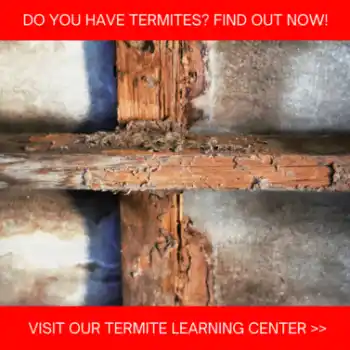Termites, Carpenter Ants, or Beetles?
Serving Illinois and Indiana

No one wants to hear the word “termites” when it comes to their commercial property or their home, and the words “carpenter ants” or “beetles” bring no relief either. Each year, we receive numerous panicked phone calls when home and property owners start finding small and large winged critters flying all over the place. You might be finding these winged pests around your home or commercial property, around doors, windows, showers, and toilets. When your home or property becomes invaded with these winged pests, the first reaction is to usually blame termites, but termites might not actually be responsible for the damage.
Do You Have Carpenter Ants, Beetles, or Termites?
Carpenter ants, beetles, and termites share a lot of traits, the main shared trait being that they are all attracted to wood. Listed below is more information on how you can determine if termites are the cause of your damage, or if you might be facing a carpenter ant or beetle infestation instead.
- Termites
- There are many different types of termites, with the most common type being the subterranean species.
- Like carpenter ants, termites have a sort of “pest hierarchy,” including worker termites, soldier termites, and swarmer termites. Worker termites tend to be cream colored and wingless, while soldier termites tend to have a large brown head with large wingless cream-colored bodies. Swarmer termites are typically a little bit easier to spot, as they are black in color and have two wings.
- Termites are especially drawn to any structure that is composed of wooden or cellulose-based materials, such as your floors and wood trims, decks and fences, walls and ceilings, roofs and tiles, and foundations.
- If you are seeing an increasing presence of termite swarmers, termite wings, termite frass (wood shavings or droppings), termite mud tubes, or damaged wood, it is likely that you have a termite infestation.
- Carpenter Ants
- Like termites, carpenter ants build colonies. The carpenter ant queen is in charge of the parent colony, and the worker ants will go forth and find new nesting sites, much like swarmer termites do.
- Carpenter ant colonies typically don’t grow as quickly or to the extent that termite colonies do, but they can still wreak havoc on your home and property.
- Carpenter ants have a “parent” colony and a “satellite” colony and establish communication and travel between the two by creating trails. Parent colonies are most often created within tree stumps, chopped down or rotting trees, sheds, homes, and commercial properties.
- Carpenter ants are typically black in appearance, although they can also be red or brown in color.
- One of the biggest difference between termites and carpenter ants is why they destroy wood. Carpenter ants do not actually eat wood; they excavate it in order to expand upon their own nests.
- Signs of carpenter ant infestation include the presence of frass or the tiny shavings of wood produced when they excavate. In some cases, you may also hear carpenter ants in your walls as they excavate wood for their nests.
- Wood-Boring Beetles
- Wood-boring beetles can be identified by their long, narrow, flat bodies. These pests have six legs, grow to 1/32 to 1/4 inches in length, and are reddish brown to black in color.
- The way that their bodies are shaped allows them to easily attack and bore into wood surfaces, often turning them into masses of very fine powder-like material.
- Female beetles will lay eggs on hardwoods and rough wood surfaces. The larvae will then burrow into the wood, and then one to five years later, they will emerge from the infested wood.
- Wood-boring beetles can be difficult to spot as they spend most of their lives living inside of wood undetected. These pests are especially attracted to ash, oak, hickory, and walnut.
- Because these beetles like to bore into wood, their destruction can be slightly easier to diagnose, as there will be small exit holes measuring from 1/4 to 3/8 inch in diameter where adult beetles have emerged from the wood.
Ready For a Free Pest Control Quote?
Click the button below to leave your information and we’ll be in touch with a free quote!
Expert Wood-Boring Insect Exterminators in the Midwest
While termites, carpenter ants, and beetles can cause large amounts of damage to any type of home or property, don’t panic. Unsure of which type of pest is causing your infestation? Our licensed extermination specialists are trained and knowledgeable about the differences and similarities between these common pests, and can provide a pest management plan that will fit your needs, eliminate the problem, and keep your home protected.




